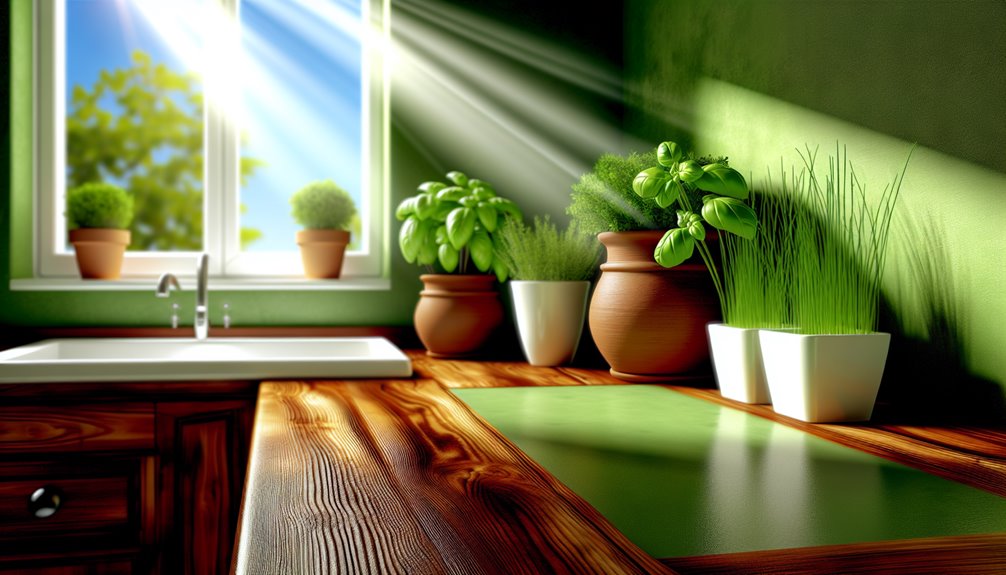Choosing the right pots for your herbs in the kitchen is key for growth. Opt for breathable materials like terracotta or ceramic, ensuring they have drainage holes. For most herbs, pots should be at least 6-8 inches deep. Basil and mint need larger pots, while parsley and chives can thrive in smaller ones. Always position your pots near a window with ample sunlight. Want to explore more about herb care and stylish pot options? Keep going!
Key Takeaways
- Choose breathable materials like terracotta or ceramic to promote moisture control for your herbs.
- Ensure pots have drainage holes to prevent root rot and overwatering.
- Select pots that are at least 6-8 inches deep for adequate root growth.
- Place pots near windows for at least 6 hours of sunlight daily to support healthy growth.
- Consider stylish ceramic designs that enhance your kitchen’s aesthetics while providing functionality.
Choosing the Right Pots for Your Herbs
When selecting pots for your herbs, what should you consider to guarantee they thrive?
First, focus on herb potting materials. Choose pots made from breathable materials like terracotta or ceramic, which help with moisture control. Avoid plastic unless it has drainage holes.
Next, think about pot size considerations. Ideally, your pots should be at least 6-8 inches deep for adequate root growth. Smaller pots can limit growth, while excessively large pots may retain too much moisture.
Lastly, make sure your pots have proper drainage to prevent root rot. This way, your herbs will flourish, providing you with fresh flavors for your meals.
Keep these factors in mind, and you’ll set your herbs up for success!
Best Herbs to Grow in Pots
While you can grow a variety of herbs in pots, some stand out for their adaptability and flavor.
Choosing the right herbs can enhance your cooking and make the most of your pot size for ideal herb growth. Here are four top picks for your kitchen garden:
- Basil: Thrives in warm weather and needs a larger pot for healthy growth.
- Parsley: A versatile herb that grows well in smaller pots and can be harvested continually.
- Chives: Perfect for smaller spaces, they grow densely and add a mild onion flavor.
- Mint: Grows vigorously, so a larger pot is essential to keep it contained.
These herbs can flourish in pots, bringing fresh flavors right to your kitchen!
Tips for Caring for Potted Herbs
Growing herbs in pots is just the beginning; caring for them properly guarantees they thrive and provide you with fresh flavors for your dishes.
Start with herb watering—ensure your pots have drainage holes to prevent overwatering. Check the soil regularly; it should be moist but not soggy. Adjust your watering schedule based on the season and your herbs’ needs.
For pest management, keep an eye out for common pests like aphids and spider mites. Use insecticidal soap or neem oil to treat infestations promptly.
You can also introduce beneficial insects like ladybugs to help control pests naturally. With consistent care, your potted herbs will flourish, offering you a bountiful supply of fresh ingredients right from your kitchen.
Ideal Placement for Your Herb Pots
Choosing the right spot for your herb pots can make all the difference in their growth and flavor.
To guarantee your herbs thrive, consider these key factors:
- Light Exposure: Place your pots near a window where they can soak up at least 6 hours of sunlight daily.
- Humidity Levels: Keep your herbs in a location with moderate humidity; too dry or too damp can hinder growth.
- Air Circulation: Assure good airflow around your pots to prevent mold and pests.
- Accessibility: Position your pots where you can easily reach them for watering and harvesting.
Stylish Pot Options for Your Kitchen
When you’re looking to enhance your kitchen’s aesthetic, selecting stylish pots for your herbs can make a significant impact.
Consider ceramic designs that blend functionality with flair. These pots not only provide excellent drainage but also come in various colors and patterns, adding a touch of personality to your space.
Opt for sleek, modern aesthetics that complement your kitchen’s theme; minimalist black or white pots can create a chic look, while vibrant hues can add a playful vibe.
You might also explore unique shapes, like geometric or hanging designs, that draw the eye.
Frequently Asked Questions
Can I Use Outdoor Pots for Indoor Herb Gardening?
Oh sure, why not? Just toss those outdoor pots in your living room! But really, outdoor pot suitability varies; make sure they’re clean and provide proper drainage for effective indoor herb care. Your herbs will thank you!
How Often Should I Repot My Herbs?
You should repot your herbs every one to two years, depending on their growth. Regular repotting helps promote healthy herb growth, ensuring they have enough space and nutrients for thriving in their environment.
What Size Pots Are Best for Larger Herb Plants?
When your herbs grow like wildflowers, you’ll need larger containers. Choose large herb containers, ideally 12-16 inches wide, to give them room to breathe and flourish. The right herb potting sizes can make all the difference!
Are There Any Herbs That Don’t Grow Well in Pots?
Some difficult herbs, like rosemary and sage, can struggle in pots due to pot limitations. They often need more space for root growth, so consider planting them in larger containers or directly in the ground.
Can I Grow Herbs From Kitchen Scraps in Pots?
Imagine a kitchen thriving with life! You can absolutely grow herbs from kitchen scraps using herb regrowth techniques and kitchen scrap methods. Just place them in water or soil, and watch them flourish anew!



